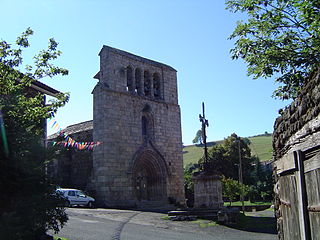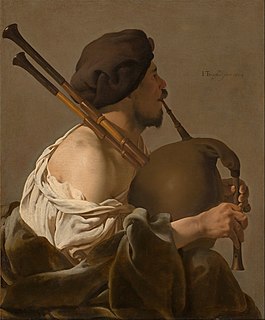
Bagpipes are a woodwind instrument using enclosed reeds fed from a constant reservoir of air in the form of a bag. The Scottish Great Highland bagpipes are the best known in the Anglophone world; however, bagpipes have been played for a millennium or more throughout large parts of Europe, northern Africa, and western Asia, including Turkey, the Caucasus, and around the Persian Gulf. The term bagpipe is equally correct in the singular or plural, though pipers usually refer to the bagpipes as "the pipes", "a set of pipes" or "a stand of pipes".
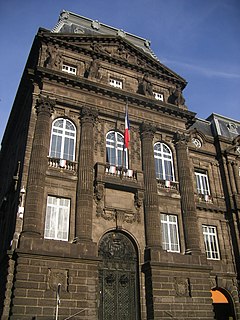
Puy-de-Dôme is a department in the centre of France named after the famous dormant volcano, the Puy de Dôme. Inhabitants were called Puydedomois until December 2005. With effect from Spring 2006, in response to a letter writing campaign, the name used for the inhabitants was changed by the Puy-de-Dôme General Council to Puydômois, and this is the name that has since then been used in all official documents and publications.

The uilleann pipes are the characteristic national bagpipe of Ireland. Earlier known in English as "union pipes", their current name is a partial translation of the Irish-language term píobaí uilleann, from their method of inflation. There is no historical record of the name or use of the term uilleann pipes before the twentieth century. It was an invention of Grattan Flood and the name stuck. People mistook the term 'union' to refer to the 1800 Act of Union; this is incorrect as Breandán Breathnach points out that a poem published in 1796 uses the term 'union'.
The music of France reflects a diverse array of styles. In the field of classical music, France has produced a number of prominent romantic composers, while folk and popular music have seen the rise of the chanson and cabaret style. The earliest known sound recording device in the world, the phonautograph, was patented in France by Édouard-Léon Scott de Martinville in 1857. France is also the 5th largest market by value in the world, and its music industry has produced many internationally renowned artists, especially in the nouvelle chanson and electronic music.
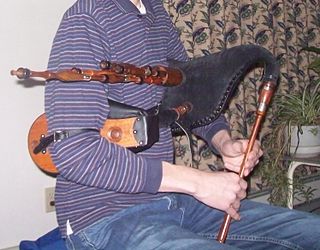
The Scottish smallpipe, in its modern form, is a bellows-blown bagpipe re-developed by Colin Ross and many others. There are many surviving bellows blown examples of similar historical instruments as well as the mouth-blown Montgomery smallpipes in E, dated 1757, which are now in the National Museum of Scotland. There is some discussion of the historical Scottish smallpipes in Collinson's history of the bagpipes. But more reliable research and information can be obtained in Hugh Cheape's "Bagpipes: A National Collection." Some instruments are being built as direct copies of historical examples, but few modern instruments are directly modelled from older examples; the modern instrument is typically larger and lower pitched. The innovations leading to the modern instrument, in particular the design of the reeds, were largely taken from the Northumbrian smallpipes.
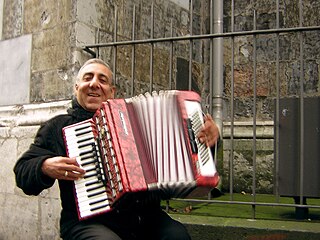
Bal-musette is a style of French music and dance that first became popular in Paris in the 1880s.
Auvergne is a region in France. Its best-known form of folk music is that played on the cabrette, a bagpipe made of goatskin. This is used to play swift, 3/8 dance music, slow airs (regrets) and other styles. The traditional master Joseph Rouls taught many modern players, including Dominique Paris, Jean Bona and Michel Esbelin. Other styles of music include the shepherd's calls known as ballero.

Auvergne is a former administrative region of France, comprising the four departments of Allier, Puy-de-Dôme, Cantal and Haute-Loire. Since 1 January 2016, it has been part of the new region Auvergne-Rhône-Alpes.
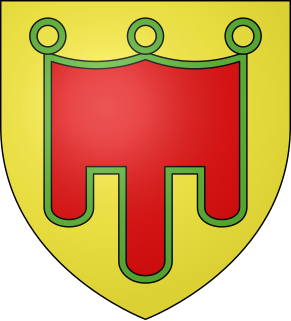
The history of the Auvergne dates back to the early Middle Ages, when it was a historic province in south central France. It was originally the feudal domain of the Counts of Auvergne.

As Europe experienced a wave of roots revivals in the 1950s and 1960s, France found its regional culture reviving traditional music. Brittany, Limousin, Gascony, Corsica and Auvergne were among the regions that experienced a notable resurgence in the popularity of folk music. Traditional styles of music had survived most in remote areas, such as the island of Corsica and mountainous Auvergne, as well as the more nationalist lands of the Basques and Bretons.

Annecy-le-Vieux is a former commune in the Haute-Savoie department in the Auvergne-Rhône-Alpes region in southeastern France. On 1 January 2017, it was merged into the commune Annecy.
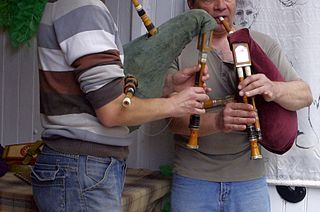
French bagpipes cover a wide range and variety of styles of bagpipes and piping, from the Celtic piping and Music of Brittany to the Northern Occitan's cabrette.

Variants of the bock, a type of bagpipe, were played in Central Europe in what are the modern states of Austria, Germany, Poland and the Czech Republic. The tradition of playing the instrument endured into the 20th century, primarily in the Blata, Chodsko, and Egerland regions of Bohemia, and among the Sorbs of Saxony. The name "Bock" refers to the use of goatskins in constructing the bag, similar to the common use of other goat-terms for bagpipes in other nations, such as the French cabrette.
The musette bressane is a type of bagpipe native to the historic French province of Bresse, in eastern France.
The musette bechonnet is a type of bellows-blown French bagpipe which takes its name from its creator, Joseph Bechonnet of Effiat.
Antoine ("Bousca") Bouscatel was a French cabrette bagpipe player, well-known at the turn of the 20th century in Paris.
Shuttle pipes are a type of bagpipes which derive their name from the drones used to produce the harmony. Rather than the long tube-like drones of most bagpipes, shuttle pipes use a shuttle drone, a cylindrical chamber enclosing a series of drone tubes, each terminating in a slot covered by a sliding "shuttle" which can be adjusted to lengthen or shorten the distance traveled by air moving through the tube, thus flattening or sharpening the pitch of the note produced.



